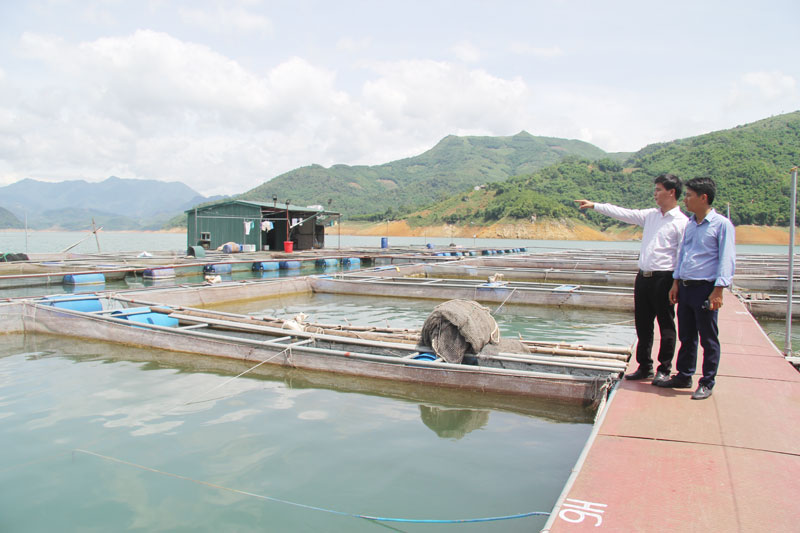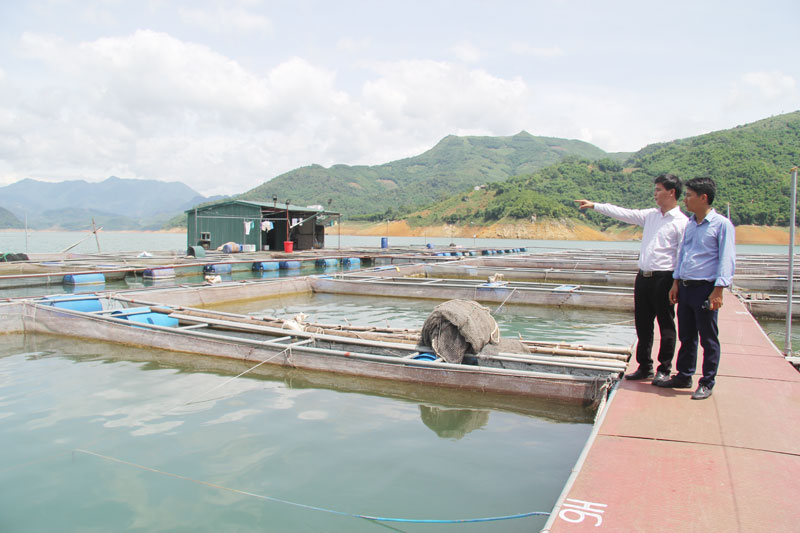
(HBO) – Hoa Binh Lake is one of the largest artificial lakes in Vietnam. Spanning 8,900 hectares in 19 communes in five districts and Hoa Binh city, the lake poses huge potential for freshwater fish raising. Many businesses have invested to expand floating cage fish farming on Hoa Binh Lake, said Hoang Van Son, head of the provincial department of fisheries said.
Hai Dang Aquaculture Co., Ltd invested in
160 cages to raise fish using high technology on
Hoa
Binh
Lake in Thai Thinh commune (Hoa Binh
city).
Hai Dang
Aquaculture Co., Ltd. has been pouring large-scale investment in
Hoa
Binh
Lake. Toan, a
representative from the company, said that
Hoa
Binh
Lake has favourable conditions for fish
farming like diversified aquatic ecosystem and clean water. The family of Bay
Tuyen began to raise fish on the Da River nearly 20 years ago. After seeing
benefits from the model, the family decided to set up the Hai Dang Aquaculture
Co., Ltd, a high-tech fish farming business. The enterprise has stable operation
with 160 cages raising lang fish (Hemibagrus guttatus), bass fish and common
carp, yielding 350 tonnes of fish per year.
The company follows a strict cultivating process and
ensures safe production. Warehouses and sale agents have been set up in
northern localities, focusing on the
Hanoimarket. Hai Dang also joined a value chain of fish raised on the Da River.
Meanwhile, Da River Clean Fish Company has 180 fish cages in Thung Nai and Vay
Nua communes. About 1 tonne of fish is consumed every day at stores in
Hanoi.
In the past years, people’s committees at all levels and provincial departments
have facilitated businesses to form large scale production areas. To date, 35
companies, cooperatives and farms have developed large-scale fish farming
model, accounting for 55 percent of the local cages and 67 percent of the
aquaculture provided for the market.
The enterprises splashed out some 200 billion VND on fish farming. Many
businesses have applied high technology in fish raising and pledged food safety
and hygiene like the Song Da Clean Fish Company, Viet Duc Company, Hai Dang
Aquaculture Co., Ltd and Minh Phu Company. They farm Chien fish (Bagarius
bagarius), lang fish, acipenser, black carp and bong fish (Oxyeleotris
marmorata), which have good productivity and gain foothold in the market.
Seven businesses have signed contracts with farmers raising fish in line with
VietGAP standards to ensure food safety. They also inked consumption contracts
with fish raisers to assure stable output.
In 2016, the provincial Department of Agriculture and Rural Development
successfully launched a food safety chain for Da River fish. In 2017 and 2018,
it will continue a value chain project for fish production in five districts
around
Hoa
Binh
Lake./.
Dao Village’s honey – a product certified with a 3-star OCOP (One Commune One Product) rating by Thong Nhat Agricultural Cooperative in Dao Village (Hoa Binh City) – is highly regarded by consumers for its quality, richness, and variety in packaging. The distinctively sweet taste of Dao Village’s honey leaves a lasting impression on anyone who has tried it.
In alignment with Project No. 07-DA/TU, issued by the Hoa Binh provincial Party Committee on November 1, 2021, Lac Thuy district has actively promoted investment and supported the sustainable development of its industrial and handicraft sectors during the 2021–2025 period. Alongside this, the district has remained committed to preserving and revitalising traditional craft villages.
Located in the northern part of Lac Thuy district, with a temperate climate and fertile soil, Phu Thanh commune has great potential and advantages in growing tea. The long-standing experience, combined with strict adherence to organic farming practices in the tea gardens, ensures that the dried tea products from Phu Thanh and Lac Thuy as a whole are sold out immediately upon production, providing a stable and prosperous life for the local people.
Amid efforts to streamline the administrative apparatus, Hoa Binh province has intensified measures to address challenges in land clearance, resettlement support, and infrastructure investment, aiming to speed up the progress of key projects.
Hoa Binh province has posted an unprecedented economic growth rate of 12.76% in the first quarter of 2025, marking its highest quarterly performance to date and positioning it as the second fastest-growing locality in the country, trailing only Bac Giang province.
Under current regulations, products in the One Commune – One Product (OCOP) programme that are rated three stars or higher must undergo re-evaluation every three months. However, in reality, some of these products fail to consistently meet the required standards, raising concerns about the sustainability of their OCOP certification. This underscores the urgent need for producers to enhance product quality and gradually develop their OCOP products into strong, marketable brands.



